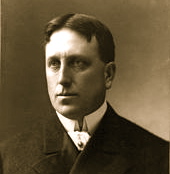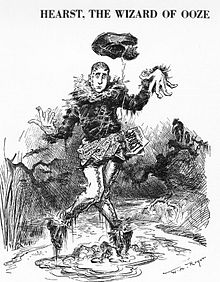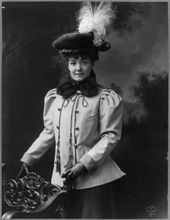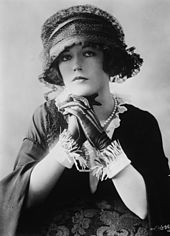Citizen Hearst

Citizen Hearst: Trailer
ABOUT CITIZEN HEARST
Citizen Hearst, directed by Academy Award-nominated filmmaker Leslie Iwerks and narrated by Academy Award nominee William H. Macy, traces the 125-year history of the Hearst media empire, from William Randolph Hearst’s pioneering and controversial days of headline-grabbing newspapers and yellow journalism, to the global impact of the company’s many successful newspaper, magazine, television and digital brands that have shaped our culture.
 William Randolph Hearst (born April 29, 1863 – died August 14, 1951) was an American newspaper publisher who built the nation’s largest newspaper chain and whose methods profoundly influenced American journalism. Hearst entered the publishing business in 1887, after taking control of The San Francisco Examiner from his father. Moving to New York City, he acquired The New York Journal and engaged in a bitter circulation war with Joseph Pulitzer‘s New York World which led to the creation of yellow journalism—sensationalized stories of dubious veracity. Acquiring more newspapers, Hearst created a chain that numbered nearly 30 papers in major American cities at its peak. He later expanded to magazines, creating the largest newspaper and magazine business in the world.
William Randolph Hearst (born April 29, 1863 – died August 14, 1951) was an American newspaper publisher who built the nation’s largest newspaper chain and whose methods profoundly influenced American journalism. Hearst entered the publishing business in 1887, after taking control of The San Francisco Examiner from his father. Moving to New York City, he acquired The New York Journal and engaged in a bitter circulation war with Joseph Pulitzer‘s New York World which led to the creation of yellow journalism—sensationalized stories of dubious veracity. Acquiring more newspapers, Hearst created a chain that numbered nearly 30 papers in major American cities at its peak. He later expanded to magazines, creating the largest newspaper and magazine business in the world.
He was twice elected as a Democrat to the U.S. House of Representatives, and ran unsuccessfully for Mayor of New York City in 1905 and 1909, for Governor of New York in 1906, and for Lieutenant Governor of New York in 1910. Nonetheless, through his newspapers and magazines, he exercised enormous political influence, and was sometimes blamed for pushing public opinion in the United States into a war with Spain in 1898.
His life story was a source of inspiration for the development of the lead character in Orson Welles‘ film Citizen Kane. His mansion, Hearst Castle, near San Simeon, California, on a hill overlooking the Pacific Ocean, halfway between Los Angeles and San Francisco, was donated by the Hearst Corporation to the state of California in 1957, and is now a State Historical Monument and a National Historic Landmark, open for public tours. Hearst formally named the estate La Cuesta Encantada (“The Enchanted Slope”), but he usually just called it “the ranch.”
Hearst was born in San Francisco to millionaire mining engineer George Hearst and Phoebe Apperson Hearst. George Hearst’s paternal grandfather, John Hearst, who was of Scottish origin, emigrated to America with his wife and six children in 1766 and settled in South Carolina. Their immigration to America was spurred in part by the colonial government’s policy that encouraged the immigration of Protestants. The names “John Hearse” and “John Hearse Jr.” appear on the council records on the October 26, 1766, being credited with meriting 400 acres (1.6 km2) and 100 acres (0.40 km2) of land on the Long Canes (in what became Abbeville District), based upon 100 acres (0.40 km2) to heads of household and 50 acres (200,000 m2) for each dependent of a Protestant immigrant. The “Hearse” spelling of the family name never was used afterward by the family members themselves, or any family of any size. A separate theory purports that one branch of a “Hurst” family of Virginia (originally from Plymouth Colony) moved to South Carolina at about the same time and changed the spelling of its surname of over a century to that of the emigrant Hearsts. Hearst’s mother was of Irish ancestry; her family came from Galway.
Following preparation at St. Paul’s School in Concord, New Hampshire, Hearst enrolled in the Harvard College class of 1885, where he was a member of Delta Kappa Epsilon fraternity (Alpha chapter), the A.D. Club (a prestigious Harvard Final club), and of the Harvard Lampoon before being expelled for antics ranging from sponsoring massive beer parties in Harvard Square to sending chamber pots to his professors (their images were depicted within the bowls).
Publishing business
 An ad asking automakers to place ads in Hearst chain, noting their circulation.
An ad asking automakers to place ads in Hearst chain, noting their circulation.
Searching for an occupation, in 1887 he took over management of a newspaper which his father had purchased in 1880, the San Francisco Examiner. Giving his paper a grand motto, “Monarch of the Dailies”, he acquired the best equipment and the most talented writers of the time, including Ambrose Bierce, Mark Twain and Jack London. A self-proclaimed populist, Hearst went on to publish stories of municipal and financial corruption, often attacking companies in which his own family held an interest. Within a few years, his paper dominated the San Francisco market.
New York Morning Journal
In 1895, with the financial support of his mother, he bought the failing New York Morning Journal, hiring writers like Stephen Crane and Julian Hawthorne and entering into a head-to-head circulation war with Joseph Pulitzer, owner and publisher of the New York World, from whom he “stole” Richard F. Outcault, the inventor of color comics, and all of Pulitzer’s Sunday staff as well. Another prominent hire was James J. Montague, who came from the Portland Oregonian and started his well-known “More Truth Than Poetry” column at the Hearst-owned New York Evening Journal.
Hearst’s newspaper was the only major publication in the East to support William Jennings Bryan and Bimetallism in 1896. Subsequently, the price of the Journal (laterNew York Journal-American) was reduced to one cent; this, coupled with the newspaper’s eye-catching headlines and sensational stories on subjects like crime and pseudoscience (a style pejoratively referred to as yellow journalism—see below) allowed the newspaper to attain unprecedented levels of circulation.
Expansion
In part to aid in his political ambitions, Hearst opened newspapers in some other cities, among them Chicago, Los Angeles and Boston. The creation of his Chicago paper was requested by the Democratic National Committee and Hearst used this as an excuse for Phoebe Hearst to transfer him the necessary start-up funds. By the mid-1920s he had a nation-wide string of 28 newspapers, among them the Los Angeles Examiner, the Boston American, the Atlanta Georgian, the Chicago Examiner, the Detroit Times, the Seattle Post-Intelligencer, the Washington Times, the Washington Herald, and his flagship the San Francisco Examiner.
Hearst also diversified his publishing interests into book publishing and magazines; several of the latter still appear, including such periodicals as Cosmopolitan, Good Housekeeping, Town and Country and Harper’s Bazaar.
 Cartoonist Rogers in 1906 sees the political uses of Oz: he depicts William Randolph Hearst as the Scarecrow stuck in his own Ooze in Harper’s Weekly.
Cartoonist Rogers in 1906 sees the political uses of Oz: he depicts William Randolph Hearst as the Scarecrow stuck in his own Ooze in Harper’s Weekly.
In 1924 he opened the New York Daily Mirror, a racy tabloid frankly imitating the New York Daily News. Among his other holdings were two news services, Universal News and International News Service (INS) (which he founded in 1909). He also owned INS companion radio station WINS in New York); King Features Syndicate; a film company, Cosmopolitan Productions; extensive New York City real estate; and thousands of acres of land in California and Mexico, along with timber and mining interests.
Hearst’s father, US Senator George Hearst, had acquired land in the Mexican state of Chihuahua after receiving advance notice that Geronimo – who had terrorized settlers in the region – had surrendered. George Hearst was able to buy 670,000 acres (270,000 ha), the Babicora Ranch, at 20–40 cents each because only he knew that they had become much more secure. George Hearst was on friendly terms with Porfirio Díaz, the Mexican dictator, who helped him settle boundary disputes profitably. The ranch was expanded to nearly 1,000,000 acres (400,000 ha) by George Hearst, then by Phoebe Hearst after his death. The younger Hearst was at Babicora as early as 1886, when he wrote to his mother that “I really don’t see what is to prevent us from owning all Mexico and running it to suit ourselves.” During the Mexican Revolution, his mother’s ranch was looted by irregulars under Pancho Villa. Babicora was then occupied by Carranza’s forces. Phoebe Hearst willed the ranch to her son in 1919. Babicora was sold to the Mexican government for $2.5 million in 1953, just two years after Hearst’s death.
Hearst promoted writers and cartoonists despite the lack of any apparent demand for them by his readers. The press critic A. J. Liebling reminds us how many Hearst stars would not be deemed employable elsewhere. One Hearst favorite, George Herriman, was the inventor of the dizzy comic strip Krazy Kat; not especially popular with either readers or editors, it is now considered by many to be a classic, a belief once held only by Hearst himself.
 Two months before the Wall Street Crash of 1929, he became one of the sponsors of the first round-the-world voyage in an airship, the LZ 127 Graf Zeppelin. His sponsorship was conditional on the trip starting at Lakehurst Naval Air Station, NJ, so the ship’s captain, Dr. Hugo Eckener, first flew the Graf across the Atlantic from Germany to pick up Hearst’s photographer and at least three Hearst correspondents. One of them, Grace Marguerite Hay Drummond-Hay, by that flight became the first woman to travel around the world by air.
Two months before the Wall Street Crash of 1929, he became one of the sponsors of the first round-the-world voyage in an airship, the LZ 127 Graf Zeppelin. His sponsorship was conditional on the trip starting at Lakehurst Naval Air Station, NJ, so the ship’s captain, Dr. Hugo Eckener, first flew the Graf across the Atlantic from Germany to pick up Hearst’s photographer and at least three Hearst correspondents. One of them, Grace Marguerite Hay Drummond-Hay, by that flight became the first woman to travel around the world by air.
The Hearst news empire reached a circulation and revenue peak about 1928, but the economic collapse of the Great Depression and the vast over-extension of his empire cost him control of his holdings. It is unlikely that the newspapers ever paid their own way; mining, ranching and forestry provided whatever dividends the Hearst Corporation paid out. When the collapse came, all Hearst properties were hit hard, but none more so than the papers; adding to the burden were the Chief’s now-conservative politics, increasingly at odds with those of his readers. Having been refused the right to sell another round of bonds to unsuspecting investors, the shaky empire tottered. Unable to service its existing debts, Hearst Corporation faced a court-mandated reorganization in 1937. From this point, Hearst was just another employee, subject to the directives of an outside manager. Newspapers and other properties were liquidated, the film company shut down; there was even a well-publicized sale of art and antiquities. While World War II restored circulation and advertising revenues, his great days were over. Hearst died of a heart attack in 1951, aged eighty-eight, in Beverly Hills, California, and is buried at Cypress Lawn Memorial Park in Colma, California.
The Hearst Corporation continues to this day as a large, privately held media conglomerate based in New York City.
Involvement in politics
A Democratic member of the United States House of Representatives (1903–1907), he narrowly failed in attempts to become mayor of New York City (1905 and 1909) and governor of New York (1906), nominally remaining a Democrat while also creating the Independence Party. He was defeated for the governorship by Charles Evans Hughes.
His defeat in the New York City mayoral election, in which he ran under a short-lived third party of his own creation (the Municipal Ownership League) is widely attributed to Tammany Hall. Tammany, the dominant Democratic organization in New York City at the time (and a widely corrupt one), was said to have used every dirty trick in the book to derail Hearst’s campaign. He also sought the Democratic presidential nomination in 1904, but found that his support for William Jennings Bryan in previous years was not reciprocated. The conservative wing of the party was ascendant and nominated Judge Alton B. Parker instead. An opponent of the British Empire, Hearst opposed American involvement in the First World War and attacked the formation of the League of Nations. Hearst’s last bid for office came in 1922 when he was backed by Tammany Hall leaders for the U.S. Senate nomination in New York. Al Smith vetoed this, earning the lasting enmity of Hearst. Although Hearst shared Smith’s opposition to Prohibition he swung his papers behind Herbert Hoover in the 1928 presidential election. Hearst’s support for Franklin D. Roosevelt at the 1932 Democratic National Convention, via his allies William Gibbs McAdoo and John Nance Garner, can also be seen as part of his vendetta against Smith, who was an opponent of Roosevelt’s at that convention.
Hearst’s reputation triumphed in the 1930s as his political views changed. In 1932, he was a major supporter of Roosevelt. His newspapers energetically supported the New Deal throughout 1933 and 1934. Hearst broke with FDR in spring 1935 when the President vetoed the Patman Bonus Bill. Hearst papers carried the old publisher’s rambling, vitriolic, all-capital-letters editorials, but he no longer employed the energetic reporters, editorialists and columnists who might have made a serious attack. His newspaper audience was the same working class that Roosevelt swept by three-to-one margins in the 1936 election. In 1934 after checking with Jewish leaders to make sure the visit would prove of benefit to Jews, Hearst visited Berlin to interview Adolf Hitler. Hitler asked why he was so misunderstood by the American press. “Because Americans believe in democracy,” Hearst answered bluntly, “and are averse to dictatorship.” Hearst’s Sunday papers ran columns without rebuttal by Hermann Göring and Dr. Alfred Rosenberg.
Campaign against hemp
Hearst is commonly cited in hemp legalization circles as being the force behind making hemp illegal in the 1930’s, allegedly to make his forests more valuable.
Personal life
In 1903, Hearst married Millicent Veronica Willson (1882–1974), a 21-year-old chorus girl, in New York City. Evidence in Louis Pizzitola’s book Hearst Over Hollywood indicates that Millicent’s mother Hannah Willson ran a Tammany-connected and -protected brothel quite near the headquarters of political power in New York City at the turn of the 20th century. Millicent bore him five sons: George Randolph Hearst, born on April 23, 1904; William Randolph Hearst, Jr., born on January 27, 1908; John Randolph Hearst, born in 1910; and twins Randolph Apperson Hearst and David Whitmire (née Elbert Willson) Hearst, born on December 2, 1915.
Conceding an end to his political hopes, Hearst became involved in an affair with popular film actress and comedienne Marion Davies (1897–1961), and from about 1919, he lived openly with her in California. The affair dominated Davies’ life. Millicent separated from her husband in the mid-1920’s after tiring of his longtime affair with Davies, but the couple remained legally married until Hearst’s death. Millicent built an independent life for herself in New York City as a leading philanthropist, was active in society, and created the Free Milk Fund for the poor in 1921. After the death of Patricia Lake, Davies’ supposed niece, it was speculated that Lake was in fact Hearst’s daughter by Davies.




